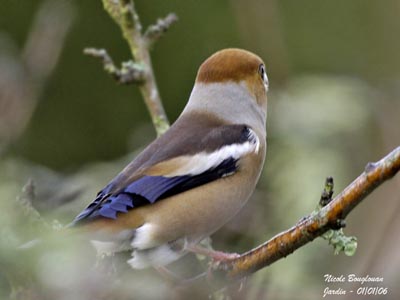
Hawfinch
Coccothraustes coccothraustes
Passeriforme Order – Fringillidae Family
BIOMETRICS :
Lenght : 16-18 cm
Weight : 48-62 gr
DESCRIPTION :
Hawfinch is the biggest bird of the Fringillidae Family.
This bird has distinctive heavy silhouette with its “huge” bill and head, and short neck and tail.

On the upperparts, the adult male has dark brown mantle and pale buff rump. The upperwing shows conspicuous white wing patches. The flight feathers are black, and the blue primaries have flared tips. This fact is unique in Fringillidae, but maybe they are used in courtship displays.
The short tail is buff with terminal white band.
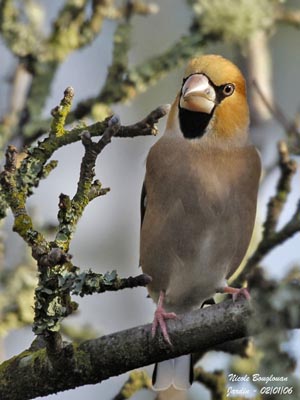
The underparts are pale pinkish brown. Vent and undertail coverts are white.
On the head, crown, nape and cheeks are buff. The head top is darker. Rear and sides of the neck are pale grey. We can see a black rounded bib. Lores are black.
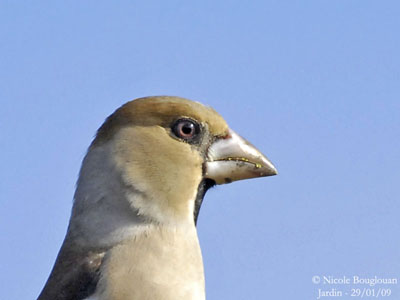
The huge bill is triangular. In breeding plumage, it is blue-black, with bluish-grey base. In winter, the bill is horn-coloured. Eyes are pinkish-brown. Legs and feet are pink.
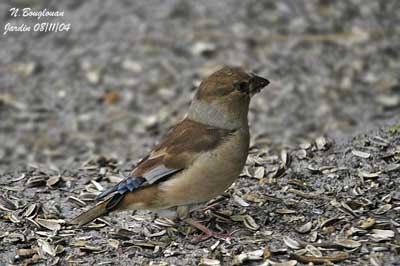
Female resembles male, but she is duller. She has slaty-grey patch on the secondary feathers. The black bib is slightly smaller than in male.
The juvenile has pale greyish-yellow breast, and the underparts are mottled black. It lacks the black bib. Its bill is pale yellowish.
The young male shows some black at the base of the bill. Underparts are darker than in adults.
VOICE: SOUNDS BY XENO-CANTO
Hawfinch’s typical call is an explosive “tick”, and also a thin “seep”. While is moving among branches, it utters a short, soft “sib”. When flying between two trees, it utters “tsik”. If it is threatened, it gives an anxious “kiou”. In flight, we can hear a metallic “tsicc” loud and distinct.
The song is a quiet whistling sound interspersed with call notes, rather guttural, without any musical notes “tchi-tchi…ter-ui-ui”.
HABITAT:
Hawfinch frequents deciduous and mixed forests, orchards, parks and also the vegetation along the streams.
RANGE:
Hawfinch breeds throughout Europe and temperate Asia. The European population is usually resident. The Asian birds migrate southwards in winter.
BEHAVIOUR:
Hawfinch feeds mainly on seeds taken on the ground or directly from the trees. It catches insects during summer, in order to feed its young.
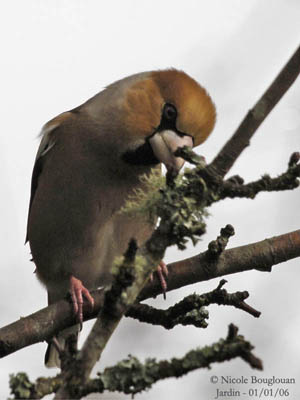
But the Hawfinch is mainly known for feeding the seeds extracted from thick stones, such as olives or cherries. It is able to crack open the shells, thanks to its massive bill and head. The skull is adapted to this feeding behaviour, allowing the strong muscles to manage this work.
The interior of the bill is raspy and helps for holding the stones.
This bird may develop strength of about 45 kg for breaking a stone!
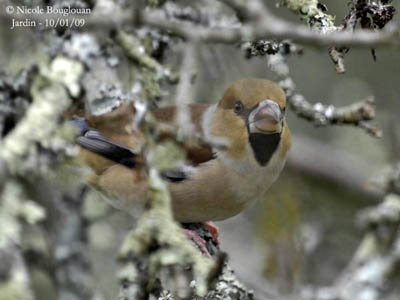
Hawfinch is shy and secretive, and difficult to see. It is often perched high in trees, hidden among the foliage. If disturbed, the bird flies up to the treetop. It will descend slowly, branch after branch, observing the surroundings.

When the breeding season starts, the male sings for attracting a female. If the female accepts, the male starts to display. It fluffs head and breast feathers, bows with dropped wings and fanned tail. The wing dropping allows the male to expose the iridescent deep blue flight feathers.
Female goes towards the male and looks at him with interest. She has sleek body feathers. She hops laterally or takes off, followed by the male which performs deep bowing, in order to display the grey nape, pointing the bill downwards to its belly or legs. Then, male goes towards the female with wings broadly opened. She holds the bill towards him, and the birds end their displays in the same posture, bill to bill, as for a kiss. Male also performs courtship feeding and flight displays above female, chasing her among and around the trees.
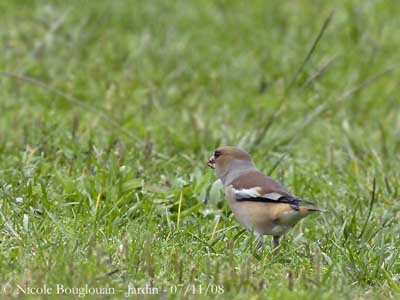
Hawfinches gather in flocks after breeding season and feed on the ground.
FLIGHT:
Hawfinch performs undulating flight at good height. The white patches are very conspicuous in flight. Flight displays involve “moth-like” flight with short fluttering wings above female.
REPRODUCTION:
Breeding season occurs in late April.
Hawfinch may nest in loose colonies of about six pairs, sometimes up to twenty.
The nest is cup-shaped, made with twigs, grasses and lichens. It is usually placed in fork in deciduous tree, in orchards, woodlands or parks.
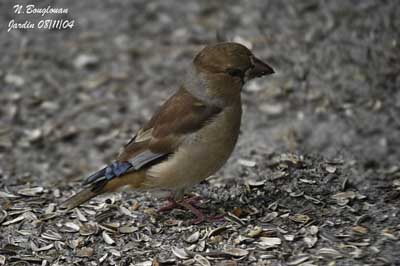
Female lays 2 to 7 pale blue or greenish eggs with some black markings. Incubation lasts about 9 to 14 days, by female. Young are fed by both adults with regurgitated insects and seeds. They fledge 10 to 14 days after hatching.
This species may produce one or two broods per season.
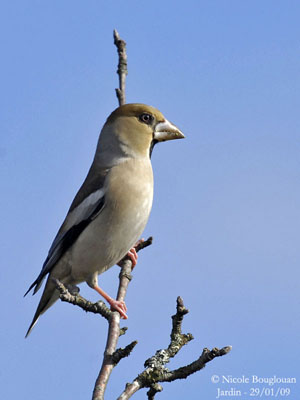
DIET:
Hawfinch feeds mainly on seeds from hornbeam and beech, but it also consumes seeds of other plant species. It can take oak buds, and during summer, it catches insects. It is able to break open the cherry-stones, thanks to its massive bill.
PROTECTION / THREATS / STATUS:
Hawfinch is very difficult to observe, and estimations are not easy to do. However, this species declined in the last years, due to disturbances and changes in the habitat.
Fr: Grosbec casse-noyaux
All : Kernbeisser
Esp : Pepitero Común
Ital : Frosone
Nd : Appelvink
Russe : Дубонос
Sd : Stenknäck
Texte et photos de Nicole Bouglouan
Sources :
L’ENCYCLOPEDIE MONDIALE DES OISEAUX - Dr Christopher M. Perrins - BORDAS - ISBN: 2040185607
LE GUIDE ORNITHO par Grant, Mullarney, Sven - Delachaux Niestle - ISBN: 2603011421
THE COMPLETE BOOK OF BRITISH BIRDS – Written by “Royal Society for the Protection of Birds” experts - Préface de Magnus Magnusson - Michael Cady- Rob Hume Editors - ISBN: 0749509112
THE HANDBOOK OF BIRD IDENTIFICATION FOR EUROPE AND THE WESTERN PALEARCTIC by Mark Beaman, Steve Madge - C.Helm - ISBN: 0713639601
Birds of Britain - The Web Magazine for Birdwatchers
Wikipedia (Wikipedia, The Free Encyclopedia)